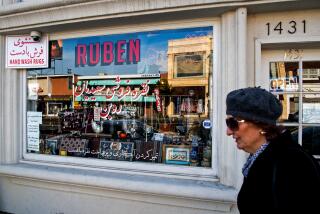A cold new era for Pakistan’s sex trade
- Share via
In 2000, Louise Brown, a sociologist at England’s Birmingham University, set out to investigate prostitution in Lahore, Pakistan. She didn’t adopt a typical academic route toward her subject; instead she spent four years, on and off, living in the city and immersing herself in its culture, observing firsthand the complexity of the place and its people.
The result of her time there is “The Dancing Girls of Lahore,” a wide-ranging look at class, gender relations and family life in a place where the ancient constantly bumps up against the modern, often in harrowing ways.
Inside Lahore is Old Lahore, an ancient walled city just a square mile in size but whose tenements and shops support a population of 250,000. Within the walled city is Heera Mandi, the Diamond Market, where courtesans for centuries sang, danced and seduced emperors in elaborate rituals and which is now a decidedly more seedy district, an area in sad decline. Although Brown has spent years researching prostitution and the trafficking of women in Asia, she finds Heera Mandi especially intriguing for its long, illustrious history. Once, she writes, the “dancing girls” found patrons in intellectual Lahori men and the Punjabi landed gentry; now Heera Mandi is considered unfashionable and hardly elite. Where the local bazaar was once filled with “function rooms” for the dancers, Brown reports that many have closed because “customers demand much less dancing these days and rather more basic sexual servicing.”
In the late 1990s, she writes, “it was clearly a community in transition, moving swiftly from an old-world brothel district steeped in artistic performance and the romance of purchased love to a more modern red-light area, stripped of elite pretensions and reliant upon the sale of sex.”
The story she tells is grim. She follows the lives of Maha, a dancer-courtesan, and her five children to illuminate the plight of Heera Mandi’s sex workers. At times, Brown’s work life blurs with her personal one, and she serves more as a sympathetic friend to Maha than detached observer. She chronicles Maha’s domestic dramas and even becomes part of them. Indeed, Brown’s narrative is more novelistic than academic -- full of vivid descriptions of her surroundings and of her interactions with local characters. Her experiences are sometimes comical; such as when a stranger on the street repeatedly tells Brown, “I very, very love you,” and tries to pay her for sex.
She describes a place in which few women are out on the street in the day, and when they are, they appear veiled and walk quickly. Girls and women between 12 and 50 tend to stay indoors for their safety and honor. “Most of their lives are spent in a handful of rooms. They don’t even go out to do the daily shopping; it’s the boys and men who run errands.” At night, the walled city offers a different scene: Women stand openly in doorways, waiting for clients, whom they discreetly refer to as their “husbands.” Officially, prostitution is illegal in Pakistan, writes Brown, as is all sex outside marriage. Although a large number of women in Pakistani jails are there for having illicit sex, Brown reports that “there is not an equivalent number of men imprisoned for having sex with a woman who is not their wife.”
Hopelessness seems to accompany many Lahori women from birth, as Brown learns that “the daughter of a dancing girl always becomes a dancing girl,” and there is little they can do to alter their fate. Maha’s daughters, Nena and Nisha, will become prostitutes, following the paths of their mother, grandmother and great-grandmother -- “women who were born, raised, and trained to please men.” The cultural prestige of being a dancing girl long gone, they are likely to experience squalor and violence instead.
“The Dancing Girls of Lahore” is fascinating, as it tells an old story but one to which most Westerners have not given much attention. Brown relates what she sees and hears without any trace of being judgmental; she tells Maha’s story with sensitivity, respect and even fondness. And she avoids breathless prose, letting the troubling facts speak for themselves.
Perhaps what might have made this book even more effective are glimpses into what hope, if any, the future holds for these women of Lahore. Is anyone working to change the lives of prostitutes, to empower them in any way? Brown takes such an intensely personal view into this world that she doesn’t step far enough outside to provide wider context and critique. Her devotion to her subject is admirable, yet a more investigative, less impressionistic approach might have yielded greater insights into this alarming, complex world.
Carmela Ciuraru is the editor of six anthologies of poetry, including “Motherhood: Poems About Mothers.”
More to Read
Sign up for Essential California
The most important California stories and recommendations in your inbox every morning.
You may occasionally receive promotional content from the Los Angeles Times.













